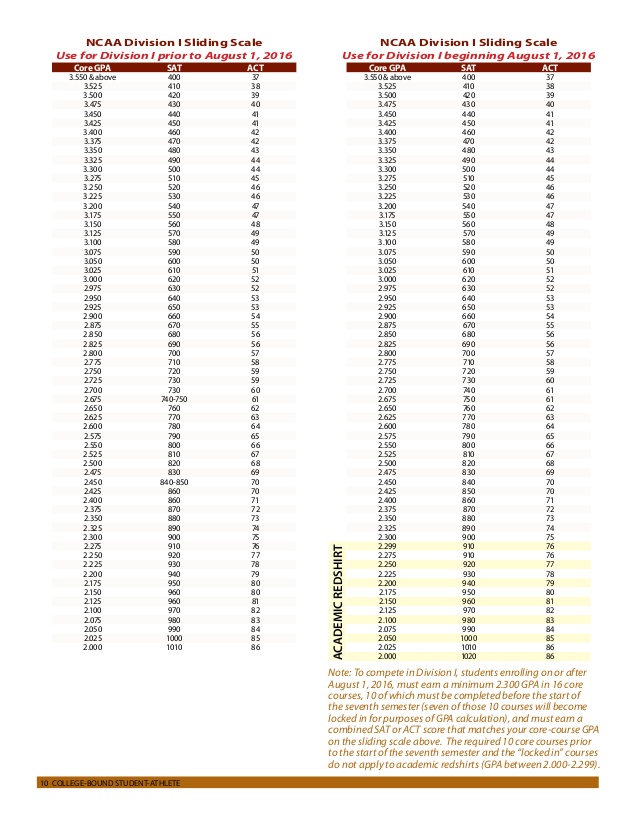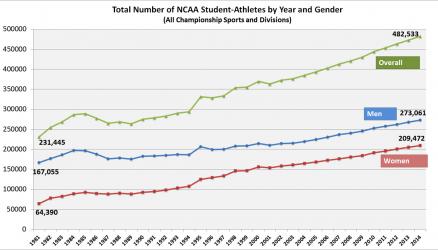

* 4 years of English
* 3 years of mathematics (Algebra I or higher)
* 2 years of natural/physical science (one must be a lab science) * 1 year of additional English, math or science
* 2 years of social studies
*4 years of additional core courses (from any area listed above, or from foreign language, nondoctrinal religion or philosophy)
Note: Computer science will no longer be used as a core course! Quick Reference Sheet

The grade point average is calculated only on courses that meet the core curriculum standards; all other courses taken in high school are eliminated and are not considered for eligibility. Each grade is considered on the following scale: A=4 points, B=3 points, C=2 points and D=1 point. This means that B+, B or B- grades are given equal weight (3 points) as an example. The eligibility scale shows that the higher the grade point average, the lower the ACT/SAT score is needed. The reverse is true as well; the lower the grade point average, then the higher ACT/SAT score. (GPA=2.5 or greater; 68 ACT/820 SAT; GPA=2.0; 86 ACT/1010 SAT)

NCAA 2015-2016 Guide for High School Counselors
The NCAA manages the daily operations of the NLI program while the Collegiate Commissioners Association (CCA) provides governance oversight of the program. Started in 1964 with seven conferences and eight independent institutions, the program now includes 650 Division I and Division II participating institutions.
The NLI is a voluntary program with regard to both institutions and student-athletes. No prospective student-athlete or parent is required to sign the NLI and no institution is required to join the program.
The NLI is a binding agreement between a prospective student-athlete and an NLI member institution.
The penalty for not fulfilling the NLI agreement: A student-athlete has to serve one year in residence (full-time, two semesters or three quarters) at the next NLI member institution and lose one season of competition in all sports.
An important provision of the NLI program is a recruiting prohibition applied after a prospective student-athlete signs the NLI. This prohibition requires member institutions to cease recruitment of a prospective student-athlete once an NLI is signed with another institution.

NCAA Athlete Nutrition (Nutrition Handouts)
Evolution of Women in College Sports (History of Title IX)



| NCAA SPORT | DIVISION I | Championship Bracket | DIVISION II | Championship Bracket | DIVISION III | Championship Bracket |
| Baseball | 295 | 64 | 271 | 32 | 385 | 42 |
| Basketball-M | 345 | 64 | 320 | 48 | 424 | 48 |
| Basketball-W | 343 | 64 | 289 | 48 | 443 | 50 |
| Field Hockey | 73 | 16 | 30 | 2 | 164 | 18 |
| Ice Hockey | 59-M/35-W | 12 | 6M/4W | n/a | 74-M/52W | 8 |
| Soccer-M | 200 | 32 | 214 | 16 | 413 | 44 |
| Soccer-W | 326 | 48 | 265 | 16 | 439 | 45 |
| Gymnastics-M | 15 | 12 | 0 | n/a | 1 | n/a |
| Gymnastics-W | 61 | 12 | 6 | n/a | 15 | n/a |
| Lacrosse | 68-M/106W | 12 | 31 | 2 | 114 | 14 |
| Football | 250 | n/a | 172 | 16 | 218 | 28 |
| Wrestling | 76 | n/a | 59 | n/a | 94 | n/a |
| Softball | 289 | 48 | 299 | 32 | 415 | 43 |
| Volleyball-M | 21 | 4 | n/a | n/a | n/a | n/a |
| Volleyball-W | 328 | 64 | 309 | 32 | 434 | 48 |
| Water Polo | 22-M/32-W | 4 | 7-M/11-W | n/a | 15-M/17-W | n/a |
| Swimming&Diving | 134-M/195-W | n/a | 72-M/98W | n/a | 221-M/255-W | n/a |
| Rifle Rowing-W Fencing |
17-M/24-W 88 20-M/24-W |
n/a n/a n/a |
4 16 2-M/4-W |
n/a n/a n/a |
4 42 n/a |
n/a n/a n/a |
| Cross Country | 311-M/342-W | n/a | 277 | n/a | n/a | n/a |
| Track-Outdoor | 278-M/329-W | n/a | 208-M/231-W | n/a | 294-M-301-W | n/a |
| Tennis Golf |
258-M/328-W 297-M/259-W |
n/a n/a |
176-M/236-W 239-M/195-W |
n/a n/a |
331-M/376-W 295-M/197-W |
n/a n/a |
| Totals-all sports | 6,475 | n/a | 4,915 | n/a | 7,981 | n/a |

| NCAA Sport | Scholarships Men | Scholarships Women | Division I Teams | Division II Teams | Total Teams | HC=Head Count/EQ=Equity | Notes |
| Baseball | 11.7 | n/a | n/a | n/a | 1600 | EQ | |
| Basketball | 13 | 15 | 679 | 581 | 3600 | HC | |
| Bowling | 5 | 5 | 31 | 17 | 72 | HC | |
| Cross Country | 12.69 | 18 | 309 | 218 | n/a | EQ | |
| Fencing | 4.5 | n/a | n/a | n/a | 21 | EQ | |
| Field Hockey | n/a | 12 | n/a | n/a | n/a | HC | |
| Football | 85 | n/a | n/a | n/a | n/a | HC | |
| Golf | 4.5 | 6 | 521 | 335 | 1957 | EQ | |
| Gymnastics | 6.3 | 12 | 78 | n/a | 98 | EQ/HC | |
| Ice Hockey | 18 | 18 | 92 | n/a | 210 | HC | 18 spread out among 30 students |
| Lacrosse | 12.6 | 12 | 144 | n/a | n/a | EQ | |
| Rifle | 3.6 | n/a | n/a | n/a | n/a | EQ | |
| Rowing | n/a | 20 | 81 | 15 | 138 | HC | |
| Skiing | 6.3 | 7 | n/a | n/a | 74 | EQ | |
| Soccer | 9.9 | 14 | n/a | n/a | 2600 | EQ | |
| Softball | n/a | 12 | 286 | 264 | n/a | HC | |
| Swimming & Diving | 9.9 | 14 | 326 | 127 | 1040 | EQ | |
| Tennis | 4.5 | 8 | 583 | 373 | 1050 | EQ/HC | |
| Track & Field | 12.6 | 18 | n/a | n/a | n/a | EQ | |
| Volleyball | 4.5 | 12 | 329 | 286 | 1783 | EQ/HC | |
| Water Polo | 4.5 | 8 | n/a | n/a | n/a | EQ | |
| Wrestling | 9.9 | n/a | n/a | n/a | 304 | EQ | |
| Totals | 239 | 211 | 3459 | 2216 | 14547 |

| NCAA Sport | Division I | Division II | Division III | Offer |
| Baseball | 11.7 | 9 | None | |
| Basketball(M) | 13 | 10 | None | |
| Basketball(W) | 15 | 10 | None | |
| Crew (Rowing) | 20 | n/a | None | |
| Fencing-M/W | 4.5/5 | n/a | None | 43 |
| Field Hockey | 12 | n/a | None | |
| Football | 85 (I-AA:63) | 36 | None | |
| Golf (M) | 4.5 | 3.6 | None | |
| Golf (W) | 6 | 5.4 | None | |
| Gymnastics (M) | 6.3 | 6 | None | |
| Gymnastics (W) | 12 | 6 | None | |
| Ice Hockey (New: Women's) | 18 | 13.5 | None | |
| Lacrosse (M) | 12.6 | 10.8 | None | |
| Lacrosse (W) | 12 | 9.9 | None | |
| Rifle | 3.6 | n/a | None | |
| Soccer (M) | 9.9 | 9 | None | |
| Soccer (W) | 12 | 9.9 | None | |
| Softball | 12 | 7.2 | None | |
| Swimming&Diving (M) | 9.9 | 8.1 | None | |
| Swimming&Diving (W) | 12 | 8.1 | None | |
| Tennis (M) | 4.5 | 4.5 | None | |
| Tennis (W) | 8 | 6 | None | |
| Track-Indoor/Outdoor/Cross Country (M) | 12.6 | 12.6 | None | |
| Track-Indoor/Outdoor/Cross Country (W) | 18 | 12.6 | None | |
| Volleyball (M) | 4.5 | 4.5 | None | |
| Volleyball (W) | 12 | 6 | None | |
| Water Polo (M) | 4.5 | n/a | None | |
| Water Polo (W) | 8 | n/a | None | |
| Wrestling | 9.9 | 9 | None | |
| Potential Total-M | 215 | 136.6 | None | |
| Potential Total-W | 164 | 81.1 | None | |
| Totals | 379 | 217.7 | None |
NCAA Timeline of History: The Century Series
1906 – The Intercollegiate Athletic Association of the United States (IAAUS), later the NCAA, is formed.
1910 – IAAUS is renamed as the National Collegiate Athletic Association (NCAA).
1921 – The NCAA holds its first national championship, the National Collegiate Track and Field Championships.
1939 – The NCAA adds another national championship in basketball.
1952 – The NCAA headquarters are established in Kansas City.
1973 – The NCAA is divided into three subdivisions depending on level of play; Divisions I, II and III.
1978 – The NCAA divides Division-I football into their own subdivisions, Division-IA and IAA.
1983 – The NCAA starts athletic programs and competition for women.
1984 – The Presidents Commission, made of presidents from all divisions in the NCAA, is formed. The presidents set the agenda and plans for the Association.
2010 – The NCAA has approximately 1200 members across the country.